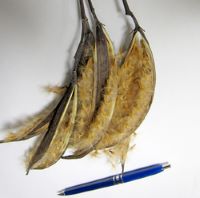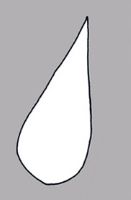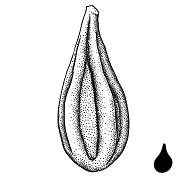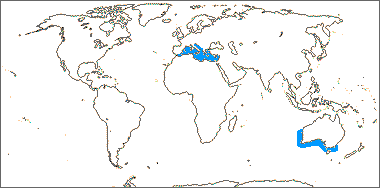Family name: Posidoniaceae Vines
Synonym(s): [none]
Common name(s): posidonia family
*Number of genera/species: 1/9
List of genera records in GRIN-Global
fruit (dehisced or not) or seed
Fruit a folliclefollicle:
a dry to (rarely) fleshy fruit derived from a single carpel that opens along a single longitudinal suture, derived from a single, superior, simple ovary; the seeds may be arillate or with a fleshy testa or drupedrupe:
or drupedrupe:
(indehiscent drupe) a fleshy, indehiscent fruit with one more hard pits enclosing seeds, derived from single, superior, simple or compound ovary; (dehiscent drupe) a fruit with a dry or fibrous to fleshy or leathery outer husk that early to tardily breaks apart (or opens), exposing one or more nutlike pits enclosing the seeds , 1.5–40 mm long, oblongoblong:
, 1.5–40 mm long, oblongoblong:
2D shape—much longer than broad with nearly parallel sides, corners are rounded to ovateovate:
to ovateovate:
2D shape—egg-shaped in outline, widest point is towards one end of the organ, the other end tapers gradually, attachment at or near the broad end (compare obovate, ovoid) , tereteterete:
, tereteterete:
approximately circular in cross section; width and thickness approximately equal
 in transection, style persistent, often beakedbeak:
in transection, style persistent, often beakedbeak:
a usually firm, terminal appendage, sometimes tapered , with one seed. Pericarppericarp:
, with one seed. Pericarppericarp:
fruit wall or fruit coat
black, brown, or green to yellow, shinyshiny:
uniformly reflecting a high proportion of incident light at all angles or dulldull:
or dulldull:
reflecting only a low proportion of incident light, with no apparent sheen , fleshy or spongyspongy:
, fleshy or spongyspongy:
soft, light, discontinuous but cohesive, and somewhat resilient
.
Seeds lanceolatelanceolate:
2D shape—lance-shaped; much longer than wide, with widest point below the middle, tapering to the apex (compare oblanceolate) to teardrop-shapedteardrop-shaped:
to teardrop-shapedteardrop-shaped:
2D shape—widest point is toward one end of the fruit, the other end tapers sharply to a pointed end , tereteterete:
, tereteterete:
approximately circular in cross section; width and thickness approximately equal
 in transection, 1–25 mm long. Seed coat brown, membranousmembranous:
in transection, 1–25 mm long. Seed coat brown, membranousmembranous:
texture—extremely thin, pliable, and fairly tough
, smooth, sometimes winged.
Embryo well developed, green, macropodousmacropodous:
an embryo having an enlarged or elongated hypocotyl
.
Endosperm absent.
| Fruit | |
| Type | folliclefollicle: a dry to (rarely) fleshy fruit derived from a single carpel that opens along a single longitudinal suture, derived from a single, superior, simple ovary; the seeds may be arillate or with a fleshy testa  , drupedrupe: , drupedrupe:(indehiscent drupe) a fleshy, indehiscent fruit with one more hard pits enclosing seeds, derived from single, superior, simple or compound ovary; (dehiscent drupe) a fruit with a dry or fibrous to fleshy or leathery outer husk that early to tardily breaks apart (or opens), exposing one or more nutlike pits enclosing the seeds  |
| Size range | 1.5–40 mm long |
| Shape(s) | ovoidovoid: 3D shape—ovate  , ellipsoidellipsoid: , ellipsoidellipsoid:3D shape—elliptic , oblongoblong: 2D shape—much longer than broad with nearly parallel sides, corners are rounded  |
| Texture | fleshy, spongyspongy: soft, light, discontinuous but cohesive, and somewhat resilient |
| Color(s) | black, brown, green, yellow |
| Unique features | Fleshy or spongyspongy: soft, light, discontinuous but cohesive, and somewhat resilient , often beakedbeak: a usually firm, terminal appendage, sometimes tapered  , one-seeded folliclesfollicle: , one-seeded folliclesfollicle:a dry to (rarely) fleshy fruit derived from a single carpel that opens along a single longitudinal suture, derived from a single, superior, simple ovary; the seeds may be arillate or with a fleshy testa  or drupesdrupe: or drupesdrupe:(indehiscent drupe) a fleshy, indehiscent fruit with one more hard pits enclosing seeds, derived from single, superior, simple or compound ovary; (dehiscent drupe) a fruit with a dry or fibrous to fleshy or leathery outer husk that early to tardily breaks apart (or opens), exposing one or more nutlike pits enclosing the seeds  . . |
| Seed | |
| Size range | 1–25 mm long |
| Shape(s) | lanceoloidlanceoloid: 3D shape—lanceolate , oblongoblong: 2D shape—much longer than broad with nearly parallel sides, corners are rounded  , ellipsoidellipsoid: , ellipsoidellipsoid:3D shape—elliptic , falcatefalcate: shaped like a scythe or sickle  , teardrop-shapedteardrop-shaped: , teardrop-shapedteardrop-shaped:2D shape—widest point is toward one end of the fruit, the other end tapers sharply to a pointed end  |
| Surface relief | smooth |
| Color(s) | brown |
| Unique features | Elongated seeds with very, thin, brown seed coats and with macropodousmacropodous: an embryo having an enlarged or elongated hypocotyl , green embryos. |
| Other | |
| Embryo | well developed, green, macropodousmacropodous: an embryo having an enlarged or elongated hypocotyl |
| Nutritive tissue | endosperm absent |
Mediterranean and temperate Australian coasts.

Distribution map courtesy of Angiosperm Phylogeny Website.
Baskin and Baskin 2021Baskin and Baskin 2021:
Baskin C and Baskin J. 2021. Relationship of the lateral embryo (in grasses) to other monocot embryos: A status up-grade. Seed Science Research 31 (3): 199-210. doi:10.1017/S0960258521000209; Dahlgren et al. 1985Dahlgren et al. 1985:
Dahlgren RMT, Clifford HT, and Yeo PF. 1985. The families of the monocotyledons: structure, evolution, and taxonomy. Springer-Verlag, Berlin. 520 pp.; Flora of Australia 2021+Flora of Australia 2021+:
Flora of Australia. Australian Biological Resources Study, Canberra. Accessed January 2021–March 2024. URL: http://www.ausflora.org.au; Guerrero-Meseguer et al. 2018Guerrero-Meseguer et al. 2018:
Guerrero-Meseguer L, Sanz-Laacute;zaro C, and Mariacute;n A. 2018. Understanding the sexual recruitment of one of the oldest and largest organisms on Earth, the seagrass Posidonia oceanica . PLoS ONE 13 (11): 1-20. https://doi.org/10.1371/journal.pone.0207345; Kirkbride et al. 2006Kirkbride et al. 2006:
Kirkbride JH, Jr, Gunn CR, and Dallwitz MJ. 2006. Family guide for fruits and seeds, vers. 1.0. Accessed September 2020-January 2022. URL: https://nt.ars-grin.gov/seedsfruits/keys/frsdfam/index.cfm .; Kubitzki et al. 1990+Kubitzki et al. 1990+:
Kubitzki K et al., eds. 1990+. The families and genera of vascular plants. 7+ vols. Berlin etc.; Stevenson and Loconte 1995Stevenson and Loconte 1995:
Stevenson DW and Loconte H. 1995. A cladistic analysis of monocot families. In: Rudall PJ, Cribb PJ, Cutler DF, and Humphries CJ, eds. Monocotyledons: Systematics and Evolution. Royal Botanic Gardens, Kew.; Thiele and Adams 2014Thiele and Adams 2014:
Thiele KR and Adams LG. 2014. Families of Flowering Plants of Australia. Accessed January-December 2021. URL: https://keys.lucidcentral.org/keys/v3/FFPA/key/FFPA/Media/Html/index.htm; Watson and Dallwitz 1992+Watson and Dallwitz 1992+:
Watson L and Dallwitz MJ. 1992+. The families of flowering plants: descriptions, illustrations, identification, and information retrieval. Version: 6th Accessed September 2020-September 2022. URL: delta-intkey.com
*The number of genera and species is based on Christenhusz and Byng 2016Christenhusz and Byng 2016:
Christenhusz MJM and Byng JW. 2016. The number of known plant species in the world and its annual increase. Phytotaxa 261 (3): 201-217. https://doi.org/10.11646/phytotaxa.261.3.1, which may differ from the number of genera in GRIN-Global.